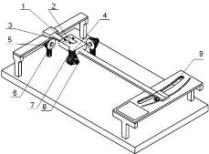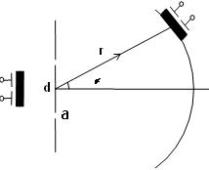
1. power switch
2. displacement display
3. display reset
4. displacement knob
5. signal input
6. emitter
7. receiver
8. signal output
9. rotation guide

Double-slit interference
Note: oscilloscope not included
Features
High performance ultrasonic sensor
Simple structure, stable and reliable
Multiple experiments
Introduction
Sound waves play a crucial role in a wide variety of scientific and engineering applications, from ultrasonic measurements in medical imaging to understanding the propagation of acoustic waves in materials. Accurate measurement of sound speed is fundamental in determining various physical parameters, such as positioning, liquid flow, and the elastic properties of materials.
The LEMI-51 Apparatus is designed to provide an in-depth exploration of sound wave phenomena, including standing waves, resonance, interference, and diffraction. With this apparatus, students can measure the speed and wavelength of sound in air, study the interference of sound waves, and observe key concepts like the "Lloyd mirror" effect and double-slit diffraction. These experiments provide hands-on experience with fundamental principles of acoustics, allowing for a better understanding of sound wave behavior and measurement techniques.
The LEMI-51 Apparatus allows users to conduct the following experiments:
1. Generate and Receive Ultrasound: Generate ultrasonic waves and detect them using a sensitive receiver. This experiment helps students understand the generation, propagation, and detection of sound waves in various media.
2. Measure Sound Speed in Air: Use phase and resonance interference methods to measure the speed of sound in air. This experiment provides an understanding of how sound waves interact with the medium and offers an opportunity to calculate the speed of sound based on experimental observations.
3. Study Interference of Reflected and Original Sound Waves (Lloyd Mirror Experiment): Investigate the interference patterns produced when sound waves reflect off a surface. This classic experiment demonstrates constructive and destructive interference and offers insight into wave behavior in real-world applications.
4. Observe and Measure Double-Slit Interference and Single-Slit Diffraction of Sound Waves: Explore the phenomena of diffraction and interference as sound waves pass through slits. By measuring the resulting interference patterns, students can gain a deeper understanding of the principles of wave mechanics and the wave nature of sound.
The LEMI-51 Apparatus provides students with the opportunity to:
1. Gain practical experience in measuring sound speed and understanding its significance in various applications, including fluid dynamics and material properties.
2. Study the fundamental principles of wave interference and diffraction, which are critical concepts in both classical physics and modern acoustics.
3. Understand the behavior of sound waves, including how they interact with surfaces and openings, offering insights into real-world phenomena like soundproofing, echoing, and acoustics in architecture.
4. Develop skills in experimental design, data analysis, and interpretation of acoustic data, with a focus on practical and repeatable results.
The instruction manual includes clear experimental configurations and setup instructions for each experiment, step-by-step guidance for performing the experiments and analyzing the results, explanations of the theoretical principles behind sound wave interference, diffraction, and speed measurement, and example results and data analysis to help students understand key concepts and verify their findings.
For further exploration of sound wave phenomena, including interference, diffraction, and speed measurement, refer to the Experiment Theory and Contents . The LEMI-51 Apparatus is an essential tool for physics labs, providing valuable hands-on experience with the key concepts of acoustics and wave mechanics.
Parts and Specifications
| Description | Specifications |
| Sine wave signal generator | Frequency range: 38 ~ 42 kHz; resolution: 1 Hz |
| Ultrasonic transducer | Piezo-ceramic chip; oscillation frequency: 40.1 ± 0.4 kHz |
| Vernier caliper | Range: 0 ~ 200 mm; accuracy: 0.02 mm |
| Ultrasonic receiver | Rotational range: -90° ~ 90°; unilateral scale: 0° ~ 20°; division: 1° |
| Measurement accuracy | <2% for phase method |

1. power switch
2. displacement display
3. display reset
4. displacement knob
5. signal input
6. emitter
7. receiver
8. signal output
9. rotation guide

Double-slit interference